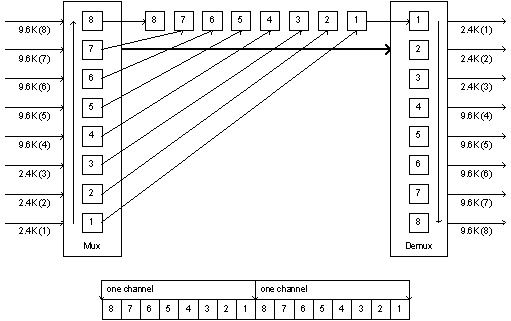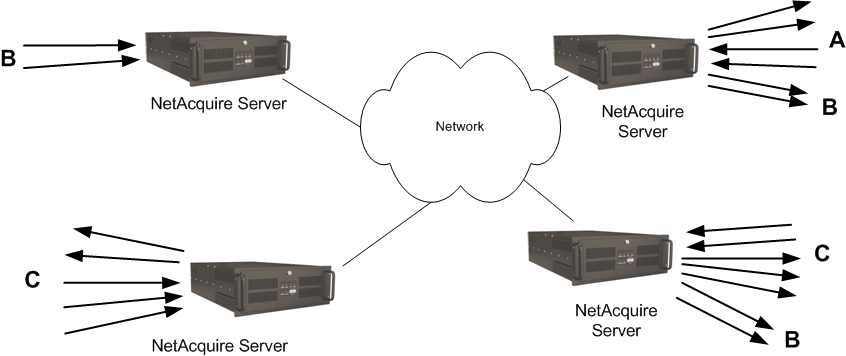TDM Multiplexer Replacement
NetAcquire Multiplexer provides a next-generation replacement to existing TDM multiplexer systems such as the Ascom Timeplex Link/2 system.
Multiplexing techniques take advantage of digital technology to share a physical communications medium between multiple data streams (channels), any of which may require some or all of the available bandwidth at any given time. Multiplexing, then, is the process of aggregating multiple low-speed channels into a single high-speed channel. Some traditional multiplexing techniques assign fixed bandwidth to each channel (e.g., Time Division Multiplexing TDM ), while others (e.g., Statistical Time Division Multiplexing STDM ) make more efficient use of the transmission facilities that interface to the network.
The NetAcquire Multiplexer option uses advanced techniques for multiplexing and demultiplexing data channels over the latest IP-based networks. The following section describes earlier approaches to data multiplexing.
Time Division Multiplexing (TDM) Background
Time Division Multiplexing (TDM) allows multiple channels to share the transmission medium by using pre-allocated time slots. All time slots comprise channels that are pre-allocated and occupy a pre-determined bit layout of the combined transmitted signal. Time slots are dedicated to a single channel, regardless of whether channel data is being transmitted or the channel is idle. And these time slots maintain their dedicated order for every frame being transmitted. Typically different time slots are dedicated to different channel services, including voice, video, or data channels. In addition, multiplexer inputs typically include asynchronous and synchronous data. Figure 1 shows a standard time division multiplexer with eight low-speed channels sharing a single high‑speed transmission line to a remote demultiplexer.
Advances in traditional time division multiplexer systems enable more efficient usage of the intermediate transmission line and provide for greater flexibility of service. For example, in Statistical Time Division Multiplexing (STDM ), the multiplexer dynamically assigns time slots to channels based on whether they need to transfer data at any given time. This provides for more dynamic allocation of bandwidth, effectively increasing channel throughput. The new generation of IP-based networks also adds challenges for multiplexers. IP networks are packet-based and multiplexer equipment must handle network jitter, retransmissions, dynamic routing changes, non-guaranteed bandwidth, and so on.
The NetAcquire Multiplexing Solution
The NetAcquire system provides multiplexer /demultiplexer capabilities (hereafter referred to as mux/demux) across a distributed, packet-switched network. The widespread adoption and flexibility of today’s Internet Protocol (IP) networks provides a cost effective, reliable, and rich communications infrastructure for which the NetAcquire system architecture has been specifically designed to use efficiently. IP network infrastructure supports all standard network protocols including the Hypertext Transfer Protocol (HTTP the Web), Simple Network Management Protocol (SNMP for system management), the File Transfer Protocol (FTP), and many others. In addition, packet-based networks offer major advantages over point-to-point communications interconnects in the areas of dynamically sharing available bandwidth and providing fault tolerant routing.
NetAcquire systems leverage the advances of IP-based networks. For example, a distributed NetAcquire system can operate across private or public internets (i.e., mux/demux components no longer need to rely on point to point interconnects). Mission-critical NetAcquire mux/demux data transfer components transparently coexist alongside other IP communications services to provide a flexible, integrated, and high performance solution.
Basic NetAcquire mux/demux operation includes the ability to multiplex together any number of input channels, transport the data through an intermediate network and, on the destination NetAcquire server, demultiplex the data back into the corresponding number of output channels.
Multiplexed input channels may represent synchronous , isochronous , or asynchronous data streams.
Reliability
The integrity of your data is maintained throughout the distribution process. NetAcquire Multiplexer preserves the relationship of the signals from the source side to the destination side. The time correlation of the source signals also is maintained and reconstituted on output.
NetAcquire Multiplexer has a unique output channel rate adaptation that prevents serial bit slips and data padding due to input-to-output timing mismatch.
Efficiency and Flexibility
Unlike traditional time division multiplexer (TDM) systems, the NetAcquire Multiplexer option does not require a dedicated T1 or T3 connection, and is much more bandwidth-efficient because it uses packet-based technology. This saves network costs and frees up bandwidth for other uses.
NetAcquire Multiplexer also eliminates the restrictions of traditional point-to-point communications. Configurable packet routing supports transferring the same data to several destinations simultaneously. In addition, groups of channels from any number of different sources can be combined at a single destination. This routing flexibility reduces both infrastructure and management costs.
Features
- Transfers data signals reliably in real-time between two or more sites connected only by a network
- Supports different types of data signals, including serial, analog, digital, and voice with a mix-and-match input/output architecture
- Low data transport latency and high throughput
- Bidirectional capability on all channels
- Automatic compensation for variable network delays
- Robust communication with automatic detection and correction of bit errors that may occur during network communication
- Transfers IRIG timing when used with the NetAcquire IRIG option
- Quality of Service (QoS) prioritization of channel priorities to maintain important channels even when network throughput decreases
- Automatic network reconnect if network infrastructure failures
- Load sharing and network path diversity provided by an optional second network interface
- Maximizes available communications bandwidth with optimized multiplexing protocol formats
- Patent pending, output channel rate adaptation avoids bit slips and data padding due to input-to-output timing mismatch
- Automatic source-to-destination data rate tracking avoids error-prone manual configuration
- Transfer of high-accuracy time-of-day data across the network with selectable precision time/data correlation
- Operates transparently with the NetAcquire High Availability Option, allowing automatic multiplexer fail-over to a second NetAcquire server if a hardware or network problem occurs


